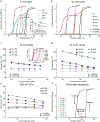Injectable tissue integrating networks from recombinant polypeptides with tunable order
- PMID: 30323334
- PMCID: PMC6329288
- DOI: 10.1038/s41563-018-0182-6
Injectable tissue integrating networks from recombinant polypeptides with tunable order
Erratum in
-
Author Correction: Injectable tissue integrating networks from recombinant polypeptides with tunable order.Nat Mater. 2018 Dec;17(12):1164. doi: 10.1038/s41563-018-0233-z. Nat Mater. 2018. PMID: 30382194 Free PMC article.
Abstract
Emergent properties of natural biomaterials result from the collective effects of nanoscale interactions among ordered and disordered domains. Here, using recombinant sequence design, we have created a set of partially ordered polypeptides to study emergent hierarchical structures by precisely encoding nanoscale order-disorder interactions. These materials, which combine the stimuli-responsiveness of disordered elastin-like polypeptides and the structural stability of polyalanine helices, are thermally responsive with tunable thermal hysteresis and the ability to reversibly form porous, viscoelastic networks above threshold temperatures. Through coarse-grain simulations, we show that hysteresis arises from physical crosslinking due to mesoscale phase separation of ordered and disordered domains. On injection of partially ordered polypeptides designed to transition at body temperature, they form stable, porous scaffolds that rapidly integrate into surrounding tissue with minimal inflammation and a high degree of vascularization. Sequence-level modulation of structural order and disorder is an untapped principle for the design of functional protein-based biomaterials.
Conflict of interest statement
Competing Financial Interests
The authors declare no competing financial interests for this work.
Figures






Comment in
-
Partial ordered polypeptides.Nat Methods. 2018 Dec;15(12):1002. doi: 10.1038/s41592-018-0249-y. Nat Methods. 2018. PMID: 30504883 No abstract available.
References
Reference Methods
-
- Karperien A FracLac for Image J, version 2.5 (http://rsb.info.nih.gov/ij/plugins/fraclac/FLHelp/Introduction.htm, 1999–2012).
Publication types
MeSH terms
Substances
Grants and funding
LinkOut - more resources
Full Text Sources
Other Literature Sources

